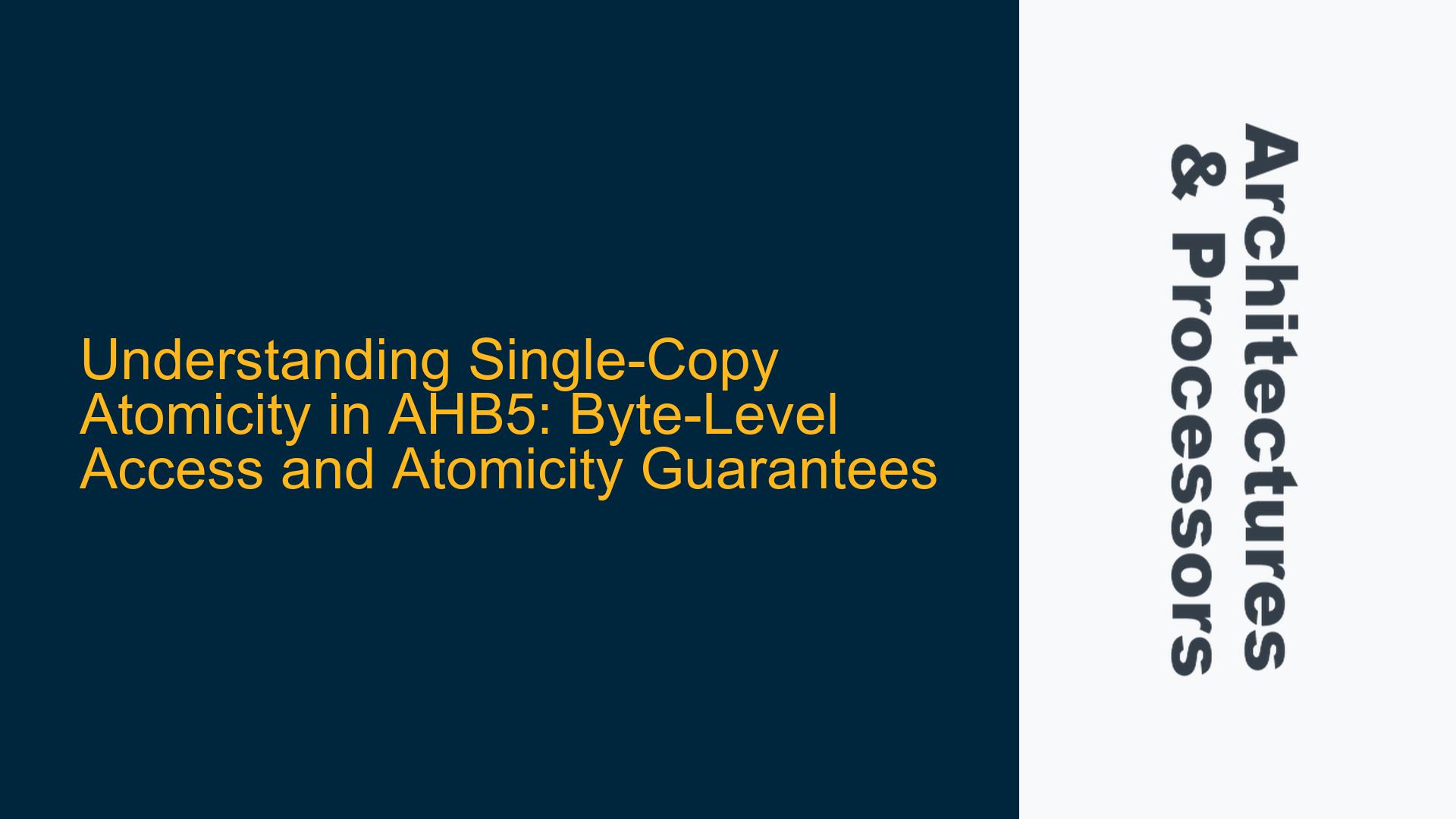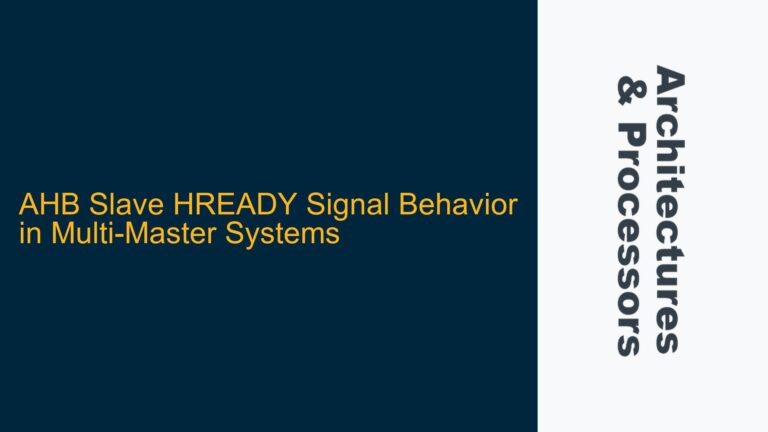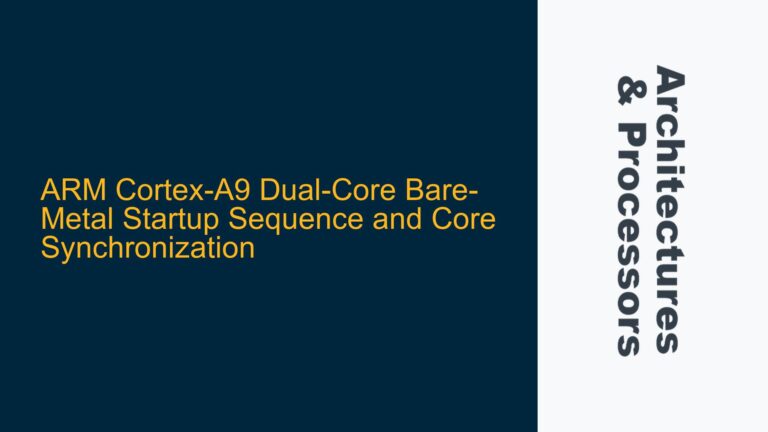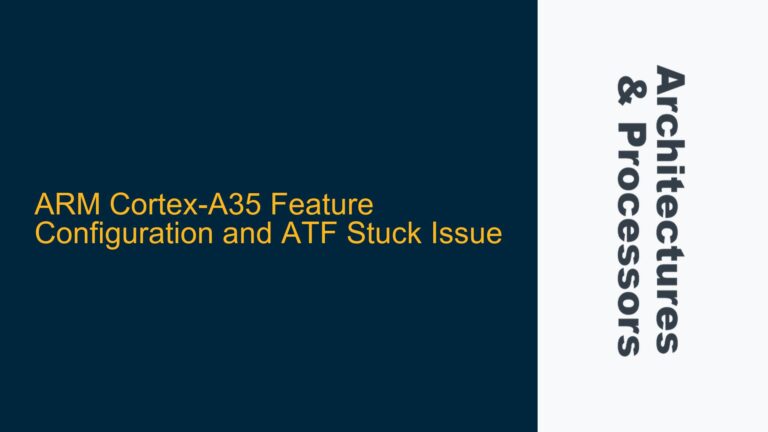ARM AHB5 Single-Copy Atomicity and Byte-Level Access Behavior
Single-copy atomicity is a critical concept in the ARM AHB5 (Advanced High-performance Bus) specification, particularly when dealing with multi-master systems or scenarios where concurrent access to shared memory regions is required. The AHB5 protocol ensures that certain memory operations are atomic, meaning that they appear to occur instantaneously from the perspective of other masters or observers in the system. This atomicity is defined by the single-copy atomicity size, which specifies the granularity at which atomic operations are guaranteed.
In the context of AHB5, a 32-bit single-copy atomic group implies that any aligned 32-bit write or read operation will be atomic. This means that no other master or observer in the system will see a partial update to the 32-bit region. However, the question arises: what happens when performing byte-level accesses (8-bit) within a 32-bit single-copy atomic group? Can a byte-level write or read operation still maintain atomicity, or does it violate the guarantees provided by the AHB5 protocol?
The AHB5 specification explicitly states that byte strobes associated with a transfer do not affect the single-copy atomicity size. This means that even if a 32-bit write operation is partially masked (e.g., only the first and last bytes are written), the operation still adheres to the 32-bit atomicity guarantee. This behavior is crucial for ensuring consistency in systems where partial writes or reads are common, such as in DMA transfers or peripheral register accesses.
To fully understand this behavior, it is essential to delve into the mechanics of AHB5 transfers. The AHB5 protocol uses signals such as HWDATA (write data), HRDATA (read data), HBURST (burst type), and HSIZE (transfer size) to control data transfers. When HSIZE is set to ‘b000, it indicates a byte-level transfer. However, the atomicity guarantees are determined by the single-copy atomicity size, not the transfer size. This distinction is critical for system designers to ensure correct behavior when implementing memory-mapped peripherals or shared memory regions.
Misconceptions About Byte-Level Access and Atomicity in AHB5
One common misconception is that byte-level accesses within a 32-bit single-copy atomic group are inherently non-atomic. This misunderstanding arises from conflating the transfer size (HSIZE) with the atomicity size. While it is true that a byte-level transfer (HSIZE=’b000) operates on a smaller granularity than the 32-bit atomicity size, the AHB5 protocol ensures that such accesses do not violate the atomicity guarantees.
For example, consider a scenario where a 32-bit memory location is part of a 32-bit single-copy atomic group. If a master performs a byte-level write to this location, the AHB5 protocol ensures that the write operation is treated as part of the 32-bit atomic group. This means that any concurrent read operation will either observe the entire 32-bit region before the write or after the write, but never a partially updated state. This behavior is maintained even if the write operation is masked to only update specific bytes within the 32-bit region.
Another misconception is that byte strobes (used to mask write data) can affect the atomicity of a transfer. The AHB5 specification explicitly clarifies that byte strobes do not impact the single-copy atomicity size. This means that even if a 32-bit write operation is partially masked (e.g., only the first and last bytes are written), the operation still adheres to the 32-bit atomicity guarantee. This behavior is crucial for ensuring consistency in systems where partial writes or reads are common, such as in DMA transfers or peripheral register accesses.
To illustrate this, consider a 32-bit write operation where only the first and last bytes are updated using byte strobes. Despite the partial update, the AHB5 protocol treats the entire 32-bit region as atomic. Any concurrent read operation will observe the region either before or after the write, but never in an intermediate state where only the first or last byte has been updated. This ensures that the system maintains consistency even when dealing with partial updates.
Ensuring Correct Implementation of AHB5 Atomicity Guarantees
To ensure correct implementation of AHB5 atomicity guarantees, system designers must carefully consider the interaction between transfer size (HSIZE), burst type (HBURST), and single-copy atomicity size. The following steps can help troubleshoot and resolve issues related to atomicity in AHB5-based systems:
-
Verify Single-Copy Atomicity Configuration: Ensure that the single-copy atomicity size is correctly configured for all memory regions in the system. This includes checking the configuration of memory controllers, DMA engines, and other peripherals that may access shared memory regions. The atomicity size should match the requirements of the system, such as 32-bit for most general-purpose systems or larger sizes for high-performance applications.
-
Analyze Transfer Size and Atomicity Interactions: Carefully analyze the interaction between transfer size (HSIZE) and single-copy atomicity size. While byte-level transfers (HSIZE=’b000) are allowed within a 32-bit atomic group, designers must ensure that these transfers do not inadvertently violate atomicity guarantees. This includes verifying that byte strobes are used correctly and that partial updates do not lead to inconsistent states.
-
Implement Proper Synchronization Mechanisms: In systems where concurrent access to shared memory regions is common, implement proper synchronization mechanisms to ensure atomicity. This may include using hardware semaphores, memory barriers, or software-based locking mechanisms. These mechanisms help prevent race conditions and ensure that all masters observe a consistent view of shared memory.
-
Test for Atomicity Violations: Perform rigorous testing to identify potential atomicity violations. This includes stress testing the system with concurrent read and write operations, as well as simulating partial updates using byte strobes. Use debugging tools and hardware monitors to observe the behavior of the system and verify that atomicity guarantees are maintained.
-
Consult the AHB5 Specification: Always refer to the AHB5 specification for detailed information on atomicity guarantees and transfer behavior. The specification provides clear guidelines on how single-copy atomicity is implemented and how it interacts with other protocol features. This is particularly important when dealing with edge cases or complex system configurations.
By following these steps, system designers can ensure that their AHB5-based systems correctly implement atomicity guarantees and avoid common pitfalls related to byte-level access and partial updates. Proper understanding and implementation of these concepts are essential for building reliable and high-performance embedded systems.
Detailed Analysis of AHB5 Atomicity and Byte-Level Access
To further clarify the behavior of AHB5 atomicity and byte-level access, let us delve into a detailed analysis of the protocol’s mechanics. The AHB5 protocol uses a combination of signals and control mechanisms to ensure that data transfers adhere to the specified atomicity guarantees. These mechanisms include the use of byte strobes, transfer size settings, and burst types, all of which interact with the single-copy atomicity size.
Byte Strobes and Their Role in AHB5 Transfers
Byte strobes are used in AHB5 to mask specific bytes within a data transfer. For example, in a 32-bit write operation, byte strobes can be used to indicate which of the four bytes should be updated. This allows for partial updates to a 32-bit region without affecting the entire region. However, the AHB5 specification explicitly states that byte strobes do not affect the single-copy atomicity size. This means that even if only certain bytes are updated, the entire 32-bit region is still treated as atomic.
Consider the following example: A 32-bit write operation is performed with byte strobes set to update only the first and last bytes. Despite the partial update, the AHB5 protocol ensures that the entire 32-bit region is treated as atomic. Any concurrent read operation will observe the region either before or after the write, but never in an intermediate state where only the first or last byte has been updated. This behavior is crucial for maintaining consistency in systems where partial updates are common.
Transfer Size and Atomicity Interactions
The transfer size (HSIZE) setting in AHB5 determines the granularity of a data transfer. For example, HSIZE=’b000 indicates a byte-level transfer, while HSIZE=’b010 indicates a 32-bit transfer. However, the atomicity guarantees are determined by the single-copy atomicity size, not the transfer size. This means that even if a byte-level transfer is performed within a 32-bit atomic group, the operation still adheres to the 32-bit atomicity guarantee.
For example, consider a 32-bit memory location that is part of a 32-bit single-copy atomic group. If a master performs a byte-level read operation (HSIZE=’b000) on this location, the AHB5 protocol ensures that the read operation is treated as part of the 32-bit atomic group. This means that any concurrent write operation will either complete before the read or start after the read, ensuring that the read operation observes a consistent state.
Burst Types and Atomicity
The burst type (HBURST) setting in AHB5 determines the sequence of data transfers within a burst. For example, HBURST=SINGLE indicates a single transfer, while HBURST=INCR4 indicates a burst of four transfers. The atomicity guarantees in AHB5 apply to each individual transfer within a burst, not the entire burst. This means that each transfer within a burst adheres to the single-copy atomicity size, ensuring that no partial updates are observed by other masters.
For example, consider a burst of four 32-bit write operations (HBURST=INCR4) within a 32-bit single-copy atomic group. Each of the four write operations is treated as atomic, meaning that no other master will observe a partial update to any of the 32-bit regions. This ensures that the system maintains consistency even during burst transfers.
Practical Implications for System Design
Understanding the interaction between byte strobes, transfer size, burst type, and single-copy atomicity is essential for designing reliable AHB5-based systems. System designers must ensure that these parameters are correctly configured to meet the requirements of the application. This includes:
- Configuring the correct single-copy atomicity size: The atomicity size should match the requirements of the system, such as 32-bit for most general-purpose systems or larger sizes for high-performance applications.
- Using byte strobes correctly: Byte strobes should be used to mask specific bytes within a transfer without affecting the atomicity guarantees. This is particularly important in systems where partial updates are common.
- Setting the appropriate transfer size: The transfer size (HSIZE) should be set to match the granularity of the data being transferred. However, designers must ensure that the transfer size does not inadvertently violate atomicity guarantees.
- Selecting the correct burst type: The burst type (HBURST) should be selected based on the sequence of data transfers required. Each transfer within a burst adheres to the single-copy atomicity size, ensuring consistency during burst operations.
By carefully considering these parameters and their interactions, system designers can ensure that their AHB5-based systems correctly implement atomicity guarantees and avoid common pitfalls related to byte-level access and partial updates.
Conclusion
Single-copy atomicity is a fundamental concept in the ARM AHB5 protocol, ensuring that certain memory operations appear instantaneous from the perspective of other masters or observers in the system. Understanding the interaction between byte-level access, byte strobes, transfer size, burst type, and single-copy atomicity is essential for designing reliable and high-performance embedded systems. By following the guidelines and troubleshooting steps outlined in this post, system designers can ensure that their AHB5-based systems correctly implement atomicity guarantees and avoid common pitfalls related to byte-level access and partial updates. Proper implementation of these concepts is crucial for building robust and efficient embedded systems that meet the demands of modern applications.






